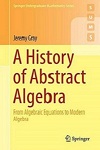Share this page:-

Congratulations, the link is avaliable for free download.
MathSchoolinternational contain thousands of
Mathematics Free Books and
Physics Free Books. Which cover almost all topics for students of Mathematics, Physics and Engineering. We have also collected other
Best Free Math Websites for teachers and students.
for teachers and students.
Here is extisive list of
Abstract Algebra ebooks . We hope students and teachers like these textbooks, notes and solution manuals.
About this book :-
A History of Abstract Algebra written by
Jeremy Gray .
This text introduces readers to the algebraic concepts of group and rings, providing a comprehensive discussion of theory as well as a significant number of applications for each. Number Theory: Induction; Binomial Coefficients; Greatest Common Divisors; The Fundamental Theorem of Arithmetic Congruences; Dates and Days. Groups I: Some Set Theory; Permutations; Groups; Subgroups and Lagrange's Theorem; Homomorphisms; Quotient Groups; Group Actions; Counting with Groups. Commutative Rings I: First Properties; Fields; Polynomials; Homomorphisms; Greatest Common Divisors; Unique Factorization; Irreducibility; Quotient Rings and Finite Fields; Officers, Magic, Fertilizer, and Horizons. Linear Algebra: Vector Spaces; Euclidean Constructions; Linear Transformations; Determinants; Codes; Canonical Forms. Fields: Classical Formulas; Insolvability of the General Quintic; Epilog. Groups II: Finite Abelian Groups; The Sylow Theorems; Ornamental Symmetry.
Commutative Rings III: Prime Ideals and Maximal Ideas; Unique Factorization; Noetherian Rings; Varieties; Grobner Bases.
Book Detail :-
Title: A History of Abstract Algebra
Edition:
Author(s): Jeremy Gray
Publisher:
Series:
Year:
Pages: 412
Type: PDF
Language: Englsih
ISBN:
Country: UK
Get Similar Books from Amazon
About Author :-
Jeremy Gray, School of Mathematics and Statistics, The Open University, Milton Keynes, UK
and Mathematics Institute, University of Warwick, Coventry, UK.
Join our new updates, alerts:-
For new updates and alerts join our WhatsApp Group and Telegram Group (you can also ask any [pdf] book/notes/solutions manual).
 Join WhatsApp Group
Join WhatsApp Group
 Join Telegram Group
Join Telegram Group
Book Contents :-
A History of Abstract Algebra written by
Jeremy Gray .
cover the following topics.
1. Simple Quadratic Forms
1.1 Introduction
1.2 Sums of Squares
1.3 Pell’s Equation
1.4 Exercises
2. Fermat’s Last Theorem
2.1 Introduction.
2.2 Fermat’s Proof of the Theorem in the Case n = 4
2.3 Euler and x3 + y3 = z3
2.4 Exercises
3. Lagrange’s Theory of Quadratic Forms
3.1 Introduction
3.2 The Beginnings of a General Theory of Quadratic Forms
3.3 The Theorem of Quadratic Reciprocity
3.4 Exercises
3.5 Taking Stock
4. Gauss’s Disquisitiones Arithmeticae
4.1 Introduction
4.2 The Disquisitiones Arithmeticae and Its Importance
4.3 Modular Arithmetic
4.4 Gauss on Congruences of the Second Degree
4.5 Gauss’s Theory of Quadratic Forms
4.6 Exercises
5. Cyclotomy
5.1 Introduction
5.2 The Case p = 7
5.3 The Case p = 19
5.4 Exercises
6. Two of Gauss’s Proofs of Quadratic Reciprocity
6.1 Introduction
6.2 Composition and Quadratic Reciprocity
6.3 Smith’s Commentary on Gauss’s Sixth Proof
6.4 Exercises
7. Dirichlet’s Lectures on Quadratic Forms
7.1 Introduction.
7.2 Gauss’s Third Proof of Quadratic Reciprocity
7.3 Dirichlet’s Theory of Quadratic Forms
7.4 Taking Stock
8. Is the Quintic Unsolvable?
8.1 Introduction
8.2 Solution of Equations of Low Degree
8.3 Lagrange (1770)
8.4 Exercises
8.5 Revision on the Solution of Equations by Radicals
9. The Unsolvability of the Quintic
9.1 Introduction.
9.2 Ruffini’s Contributions
9.3 Abel’s Work
9.4 Wantzel on Two Classical Problems
9.5 Wantzel on the Irreducible Case of the Cubic
9.6 Exercises
10. Galois’s Theory
10.1 Introduction
10.2 Galois’s 1st Memoir
10.3 From Galois’s Letter to Chevalier
10.4 Exercises
10.5 A Cayley Table of a Normal Subgroup.
10.6 Galois: Then, and Later
11. After Galois
11.1 Introduction
11.2 The Publication of Galois’s Work
11.3 Serret’s Cours d’Algèbre Supérieure
11.4 Galois Theory in Germany: Kronecker and Dedekind
12. Revision and First Assignment
13. Jordan’s Traité
13.1 Introduction
13.2 Early Group Theory: Introduction
13.3 Jordan’s Traité
13.4 Jordan’s Galois Theory
13.5 The Cubic and Quartic Equations
14. The Galois Theory of Hermite, Jordan and Klein
14.1 Introduction
14.2 How to Solve the Quintic Equation
14.3 Jordan’s Alternative
14.4 Klein
14.5 Klein in the 1870s
14.6 Klein’s Icosahedron
14.7 Exercises
15. What Is ‘Galois Theory’?
15.1 Introduction
15.2 Klein’s Influence
15.3 Concluding Remarks
16. Algebraic Number Theory: Cyclotomy
16.1 Introduction
16.2 Kummer’s Cyclotomic Integers
16.3 Fermat’s Last Theorem in Paris
17. Dedekind’s First Theory of Ideals
17.1 Introduction
17.2 Divisibility and Primality
17.3 Rings, Ideals, and Algebraic Integers
17.4 Dedekind’s Theory in 1871
18. Dedekind’s Later Theory of Ideals
18.1 Introduction
18.2 The Multiplicative Theory
18.3 Dedekind and ‘Modern Mathematics’
18.4 Exercises
19. Quadratic Forms and Ideals
19.1 Introduction
19.2 Dedekind’s 11th Supplement, 1871–1894
19.3 An Example of Equivalent Ideals
20. Kronecker’s Algebraic Number Theory
20.1 Introduction
20.2 Kronecker’s Vision of Mathematics
20.3 Kronecker’s Lectures
20.4 Gyula (Julius) König
21. Revision and Second Assignment
22. Algebra at the End of the Nineteenth Century
22.1 Introduction
22.2 HeinrichWeber and His Textbook of Algebra
22.3 Galois Theory
22.4 Number Theory
23. The Concept of an Abstract Field
23.1 Introduction
23.2 Moore, Dickson, and Galois Fields
23.3 Dedekind’s 11th Supplement, 1894
23.4 Kürschák and Hadamard
23.5 Steinitz
24. Ideal Theory and Algebraic Curves
24.1 Introduction
24.2 The Brill–Noether Theorem
24.3 The Failure of the Brill–Noether Theorem to Generalise
24.4 Lasker’s Theory of Primary Ideals
24.5 Macaulay’s Example
24.6 Prime and Primary Ideals
25. Invariant Theory and Polynomial Rings
25.1 Introduction
25.2 Hilbert
25.3 Invariants and Covariants
25.4 From Hilbert’s Paper on Invariant Theory (1890)
25.5 The Hilbert Basis Theorem and the Nullstellensatz
26. Hilbert’s Zahlbericht
26.1 Introduction
26.2 An Overview of the Zahlbericht
26.3 Ideal Classes and Quadratic Number Fields
26.4 Glimpses of the Influences of the Zahlbericht
27. The Rise of Modern Algebra: Group Theory
27.1 Introduction
27.2 The Emergence of Group Theory as an Independent Branch of Algebra
27.3 Dickson’s Classification of Finite Simple Groups
28. Emmy Noether
28.1 Introduction
28.2 Ideal Theory in Ring Domains
28.3 Structural Thinking
29. FromWeber to van derWaerden
29.1 Introduction
29.2 van der Waerden on the Origins of Moderne Algebra
30. Revision and Final Assignment
A Polynomial Equations in the Eighteenth Century
A.1 Introduction
A.2 The Fundamental Theorem of Algebra Before Gauss
B Gauss and Composition of Forms
B.1 Composition Theory
B.2 Gaussian Composition of Forms
B.3 Dirichlet on Composition of Forms
B.4 Kummer’s Observations
C Gauss’s Fourth and Sixth Proofs of Quadratic Reciprocity
C.1 Gauss’s Fourth Proof
C.2 Gauss’s Sixth Proof
C.3 Commentary
D From Jordan’s Traité
D.1 Jordan, Preface to the Traité
D.2 Jordan, General Theory of Irrationals
D.3 Jordan: The Quintic Is Not Solvable by Radicals
D.4 Netto’s Review
E Klein’s Erlanger Programm, Groups and Geometry
E.1 Introduction
E.2 Felix Klein
E.3 Geometric Groups: The Icosahedral Group
E.4 The Icosahedral Equation
F From Dedekind’s 11th Supplement (1894)
G Subgroups of S4 and S5
G.1 The Subgroups of S4
G.2 The Subgroups of S5
H Curves and Projective Space
H.1 Intersections and Multiplicities
I Resultants
I.1 Netto’s Theorem
I.2 Resultants
j FurtherReading
J.1 Other Accounts of the History of Galois Theory
J.2 Other Books on the History of Algebraic Number Theory
References
Index
Open by Cloud or
Download Similar Books
Note:-
We are not the owner of this book/notes. We provide it which is already avialable on the internet. For any further querries please contact us. We never SUPPORT PIRACY. This copy was provided for students who are financially troubled but want studeing to learn. If You Think This Materials Is Useful, Please get it legally from the PUBLISHERS. Thank you.
